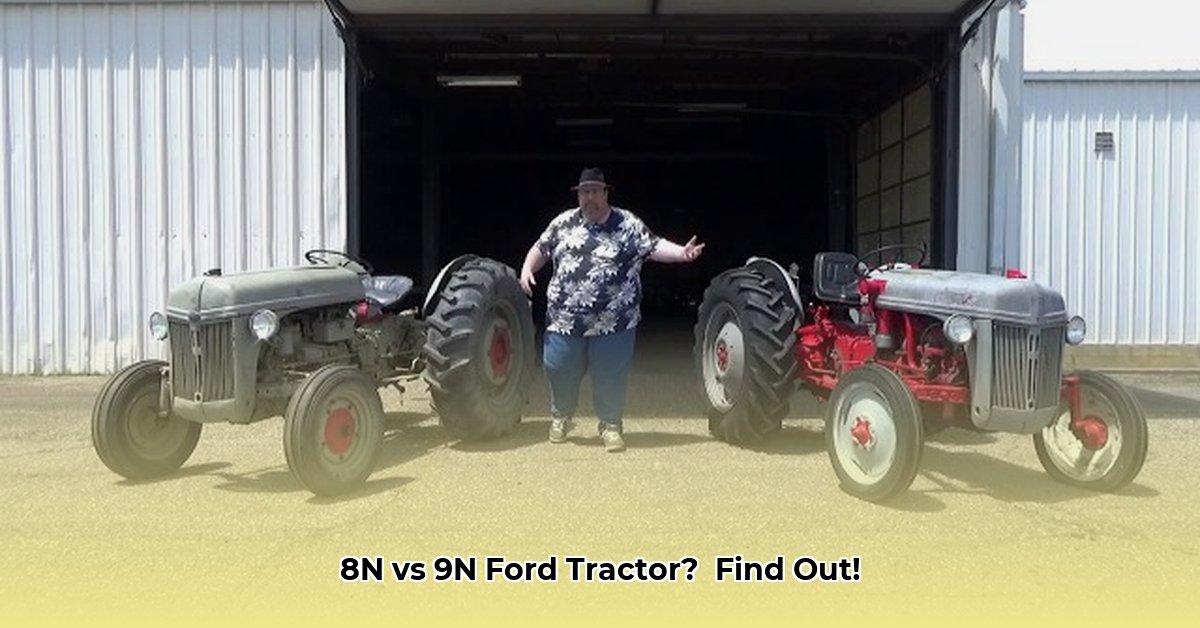
So, you've acquired a classic Ford tractor – an 8N, 9N, or perhaps even a 2N? Determining the precise model is crucial for a successful restoration. These tractors share a family resemblance, but subtle differences are key to finding the right parts and understanding its history. This guide provides a step-by-step approach to identification, tackling common challenges and offering resources for a smooth restoration. For a detailed 8N vs 9N comparison, check out this helpful guide.
Visual Clues: The Quick Check
Begin with a thorough visual inspection. Even minor details can be significant.
Rear Wheels: The 8N typically features distinctly curved, or "dished," rear wheels. The 9N and 2N usually have flatter wheels. This is often the quickest way to narrow down the possibilities.
Gearbox (Transmission): The 8N has a four-speed gearbox, while the 9N and 2N generally have three-speed transmissions. Examine the gear shift lever's position and design for additional clues.
Hydraulics: The 8N is known for its hydraulic lift system with position control. Look for the hydraulic lift levers and control components; their presence strongly indicates an 8N. Earlier models might lack this feature or have a simpler system.
Brakes: The location of the brake pedal can vary between models. Pay attention to these smaller details – they add up!
Going Deeper: More Detailed Inspection
Visual inspection is a good start, but further investigation is often necessary.
The Serial Number: Your Tractor's Identity: Every Ford tractor has a unique serial number, typically found on a data plate. This number is your key to identifying the precise model and year of manufacture. Online resources and Ford tractor enthusiast communities can help decipher this information.
Component Close-Up: Examine the shape of the fuel tank, the seat design, and the arrangement of levers and controls. These subtle differences provide valuable clues.
Engine Details: Although similar, subtle differences exist in engines across models. Consult a technical specifications guide for detailed comparisons of horsepower and design elements.
Original Documents: If you're fortunate enough to have the original owner's manual or sales literature, this provides definitive identification.
Restoration Roadblocks: Model-Specific Challenges
Restoring any of these tractors is challenging, with each model presenting unique difficulties.
Part Availability: Parts for the 8N are generally more readily available due to its longer production run and popularity. Sourcing parts for the 9N and 2N can require more effort and research.
Engine Overhaul: Engine component replacement can be a major undertaking, especially in older models. Locating the correct parts may involve contacting specialized suppliers or searching online marketplaces.
Hydraulic System Issues: The 8N's more advanced hydraulic system can introduce additional complexity. Addressing potential leaks, identifying replacement parts, and understanding the system's functionality are crucial steps.
Comparison at a Glance
This table summarizes the key differences between the models:
| Feature | 2N | 9N | 8N |
|---|---|---|---|
| Rear Wheels | Generally Flat | Generally Flat | Typically Dished |
| Transmission | 3-Speed | 3-Speed | 4-Speed |
| Hydraulics | Basic or None | Basic | Position Control |
| Brake Pedal | Location Varies | Location Varies | Location Varies |
Troubleshooting and Common Misconceptions
Deceptive Paint Jobs: A fresh paint job can mask the tractor's true identity. Inspect the underlying components for accurate identification.
"Frankenstein" Tractors: Some tractors are combinations of parts from different models. Meticulous inspection is essential to determine their origins.
Resources for Further Research
A vast community of Ford tractor enthusiasts is ready to assist you.
Ford Tractor Clubs: These clubs offer invaluable knowledge, advice, and support, serving as excellent resources for parts and restoration tips.
Online Forums: Numerous online forums dedicated to vintage tractors provide a platform to connect with experienced restorers and access a wealth of shared knowledge.
Parts Suppliers: Research and identify reputable parts suppliers specializing in classic Ford tractors.
Identifying your Ford tractor may require patience and detective work, but the reward of a successful restoration is well worth the effort. Remember, careful observation, attention to detail, and persistence are key to this rewarding journey!